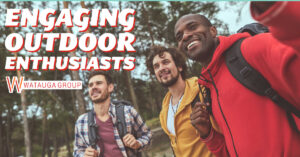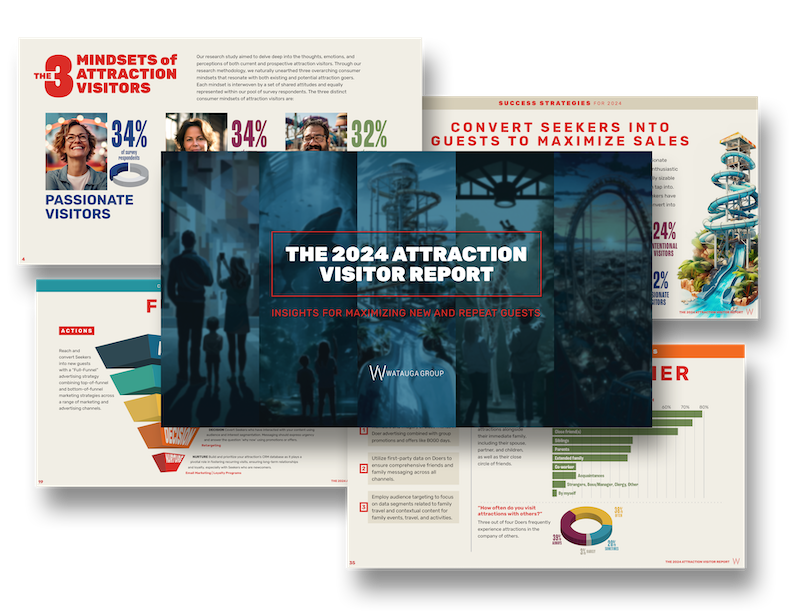Watauga’s latest research, the “2024 Attraction Visitor Report: Insights for Maximizing New & Repeat Guests,” is a game-changer for attraction marketing leaders at theme parks, zoos, aquariums, water parks, museums, and family entertainment centers. With findings derived from an extensive consumer attitudinal research study involving 3,590 participants, the report dives deep into the minds of attraction guests. This article summarizes one of the many key takeaways uncovered in the research.
The Role of Social Media in Attraction Marketing
As our research findings noted below, social media is crucial for attraction marketers at theme parks, zoos, aquariums, and similar venues because it offers a dynamic platform to engage directly with guests, showcase attraction benefits and features, and build a loyal community of visitors. By leveraging platforms like Facebook, Instagram, and TikTok, marketers can create visually appealing content that highlights unique experiences, special events, and behind-the-scenes moments, which not only attract new guests but also encourage repeat visits. Social media also allows for real-time interaction, enabling marketers to respond to inquiries, gather feedback, and foster a sense of connection with their guests. This engagement not only drives awareness and increases attendance but also enhances the overall visitor experience, making social media an indispensable tool for marketing in the attractions industry.
Understanding Visitor Mindsets, Seekers, and Doers
Our research study unveiled three distinct visitor mindsets. Passionate Visitors who prioritize meaningful moments with loved ones at attractions and consider the cost secondary. Intentional Visitors who value frugality and personal space, prioritizing their visits when it is financially affordable and when crowds are reduced. Passive Visitors who prefer familiar attractions close to home, find fulfillment in routines, and often lose interest after visiting an attraction several times.
Watauga also applied two crucial audience lenses named “Seekers” and “Doers,” to closely analyze the data and the three mindsets of attraction visitors.
Seekers are individuals who have not visited an attraction but express interest in doing so.
Doers are individuals who have either visited an attraction in the past or are current attraction guests.

The Right Time for Facebook Marketing
Refocusing your customer lens on current attraction visitors or Doers is the first step toward developing strategies to activate and engage them. Using the Doer lens, it is imperative for attraction marketing leaders to pinpoint and prioritize this audience to drive first-time visits and maximize repeat, high frequency guests.
Among all potential social media sites, our study revealed that Facebook has the biggest impact on Doers’ decision to visit and then remain enthusiastic about an attraction. Over 72% of Doers prefer using Facebook to discover and learn about attractions. In order to maximize first-time guests and drive repeat visitation among Doers, it is essential for marketing leaders at theme parks, zoos, aquariums, water parks, museums, and family entertainment centers to take a Facebook-first approach by using a combination of organic and paid marketing strategies and customizing Facebook content for the Facebook platform.
The Magic Mix: Organic and Paid Facebook Strategies
Our study uncovers that Doers overwhelmingly prefer Facebook for discovering new attractions. Therefore; marketing leaders at theme parks, zoos, aquariums, water parks, museums, and family entertainment centers should prioritize Facebook within their overall marketing strategy. One way to be sure your attraction’s message is reaching this vital potential guest is to utilize both paid social and organic social media marketing strategies. The benefit to utilizing both approaches is that it ensures your message will reach this desired Doer audience. With organic paid social content, your attraction can catch the eye of those Doers using Facebook to discover and research organically. Utilizing paid Facebook ads allows your attraction to select the exact audience you desire and ensure your message is in front of these potential guests, by targeting them with paid ads.
Social Contests, Promotions, and Followers – Oh My!
Engage this audience with both your organic and paid social Facebook marketing by implementing contests and promotions. These marketing tactics not only engage the potential new guests but also create buzz and drive excitement about your brand. Contests and promotions also serve as powerful tools to increase social sharing. About half of all Doers follow social media content about attractions. When your attraction posts a promotion or launches a contest, those posts gain traction and lead to higher follower count. The audience is eager to follow your attraction brand so they can be first-to-know about the next great offer or chance to win. These followers are likely to stay engaged with your brand once they’ve clicked “Follow”.

Conclusion: A Facebook-First Approach Maximizes Attraction Attendance
To effectively reach and engage the Doers during their discovery window, attractions must adopt a Facebook-first marketing strategy. Given that over 72% of Doers prefer Facebook for discovering and learning about attractions, it’s clear that this platform is indispensable for driving both first-time visits and repeat engagement. By leveraging a strategic mix of organic and paid Facebook content, alongside dynamic contests and promotions, attractions can not only capture the attention of potential guests but also foster ongoing excitement and loyalty. A well-executed Facebook strategy will ensure that your attraction remains top-of-mind for this vital audience, maximizing both attendance and guest enthusiasm.
To download a complimentary copy of Watauga’s 2024 Attraction Visitor Report and view an interactive visualization of the research data, please visit https://wataugagroup.com/attraction-visitor-report/.





